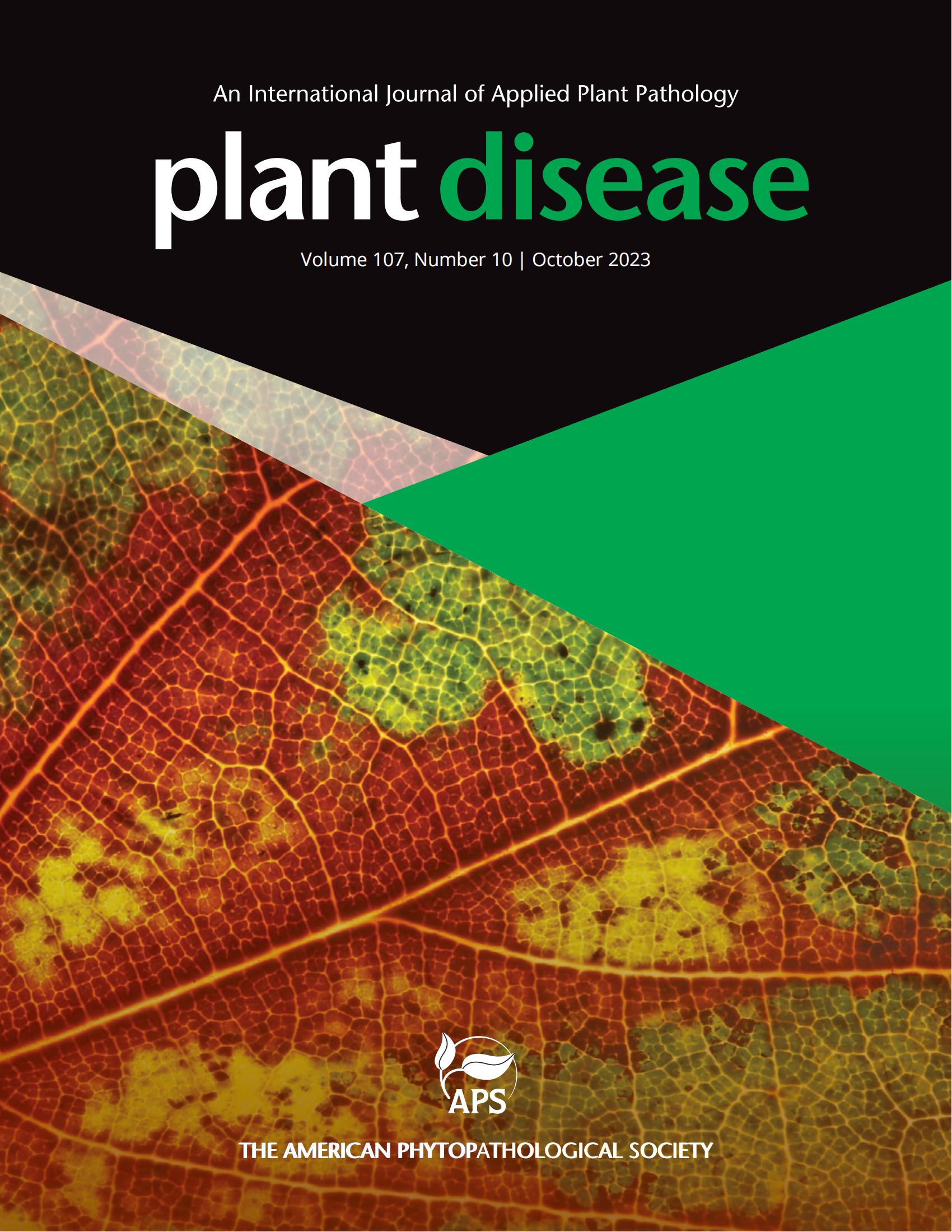黑龙江省番茄酸腐病报告初报。
摘要
番茄酸腐病是一种采后病害,是由土曲霉(Geotrichum candidum)引起的。在温带至亚热带的主要番茄产区(如美国、地中海盆地、印度)都发现了这种病害,但对中国东北地区的影响仍知之甚少。G. candidum侵染多种果蔬,包括猕猴桃、草莓、桃子等(Hussain et al., 2016;Lu et al., 2021;Cheng等人,2021)。2023年9月,黑龙江省哈尔滨市双城区长禅村番茄采后包装过程中,发现水果腐烂。从田间收获的无症状番茄在收获后两天内发生腐烂,导致9%的发病率和2.5吨的产量损失。起初,水果上出现了水样斑点。然后皮肤破裂并向外翻,露出了肉。受影响的区域变得柔软,腐烂,产生酸味,覆盖着一层白色的霉菌。收集了5个患病番茄。对病变边缘5 × 5mm组织片消毒,在PDA上28℃培养。采用单孢子分离法分离得到5株菌株。用75%乙醇对10个成熟均匀的番茄进行表面灭菌,并用30 μL 1×10⁶孢子·mL-1孢子悬浮液对5个分离株进行伤口接种。无菌水作为对照。实验进行了3次重复,所有样品在28°C、75% RH的湿室中孵育。2天后,3株分离株表现出与最初相同的症状,而对照组保持健康。从病番茄中重新分离出3种相同的病原体,而从对照中未分离出病原体。7 d后菌落直径可达7 cm,菌落呈乳白色、近圆形、粉状、扁平。镜检显示菌丝无色、分离。分生孢子直立,分生孢子为圆柱形或椭球体,端部圆形,单细胞,无色,串联排列。分生孢子长6.80±0.30 μm,宽5.51±0.59 μm (n=30)。采用改良的十六烷基三甲基溴化铵法从7天培养物中提取DNA。利用引物ITS1/ITS4、NS3/NS8 (White et al., 1990)和EF1-728F/EF1-1567R (Carbone and Kohn, 1999)分别扩增了内部转录间隔物(ITS)、18S核糖体RNA (18S rRNA)和翻译延伸因子1-α (TEF1-α)序列。聚合酶链反应(PCR)获得的序列测序并提交给GenBank。BLAST检索结果显示,ITS (PQ579186.1)、18S rRNA (PQ579206.1)和TEF1-α (PQ616986.1)序列与G. candidum (PQ836313.1、AB000652.1和OQ981192.1)序列的相似性分别为99.48%、98.03%和98.31%,与各参考序列的匹配度分别为383 bp/388 bp、1142 bp/1182 bp和638 bp/682 bp。基于ITS (388 bp)、18S rRNA (1182 bp)和TEF1-α (682 bp)的最大似然方法进行系统发育分析表明,分离菌株与相关铁皮菌型序列形成了一个支持良好的分支。分离菌株与念珠菌亲缘关系最密切,与其他菌种关系较远。经形态学和分子特征鉴定,3株分离株均为念珠菌。这是中国黑龙江省首次报道番茄酸腐病。这一发现为进一步研究该病的发生、控制和管理奠定了基础。Tomato sour rot, caused by Geotrichum candidum, is a postharvest disease. It has been detected across major tomato-producing regions in temperate to subtropical zones (e.g., United States, Mediterranean Basin, India), yet the impact in northeastern China remains poorly understood. G. candidum infects various fruits and vegetables, including kiwifruit, strawberry, peaches and so on (Hussain et al., 2016; Lu et al., 2021; Cheng et al., 2021). In September 2023, during the postharvest packing process of tomatoes in Changchan village, Shuangcheng District, Harbin City, Heilongjiang Province, rotten fruits were detected. Asymptomatic tomatoes harvested from the fields developed decay after harvest within two days, resulting in a 9% morbidity rate and 2.5-ton yield loss. Initially, watery spots appeared on the fruits. The skin then ruptured and turned outward, exposing the flesh. The affected area became soft, rotten and producing a sour odor, covered by a white mold layer. Five diseased tomatoes were collected. Tissue pieces (5 × 5 mm) from the margin of lesions were disinfected and cultured on PDA at 28°C. Five isolates were obtained using the single-spore isolation method. Ten uniformly ripened tomatoes were surface-sterilized with 75% ethanol and wound-inoculated via syringe with 30 μL of a 1×10⁶ spores·mL-1 spore suspension for each of 5 isolates. Sterile water was used as the control. Three replicates were conducted, and all samples were incubated at 28°C, 75% RH in humid chambers. After 2 days, 3 isolates showed the same symptoms as the initial, while the control remained healthy. Three same pathogens were re-isolated from the diseased tomatoes and no pathogen was isolated from the control. The diameter of colonies reached 7 cm in 7 days, appearing creamy white, suborbicular, powdery and flat. Microscopy showed the hyphae were colorless and septate. The conidiophores were erect, and the conidia were cylindrical or ellipsoid with rounded ends, single-celled, colorless, and arranged in tandem. Conidia measured 6.80 ± 0.30 μm in length and 5.51 ± 0.59 μm in width (n=30). DNA was extracted from 7-day-old cultures using a modified cetyl trimethyl ammonium bromide method. Internal transcribed spacer (ITS), 18S ribosomal RNA (18S rRNA), and translation elongation factor 1-alpha (TEF1-α) sequences were amplified using primers ITS1/ITS4, NS3/NS8 (White et al., 1990), and EF1-728F/EF1-1567R (Carbone and Kohn, 1999), respectively. The sequences obtained by polymerase chain reaction (PCR) were sequenced and submitted to GenBank. According to BLAST search, the ITS (PQ579186.1), 18S rRNA (PQ579206.1) and TEF1-α (PQ616986.1) sequences showed 99.48%, 98.03%, and 98.31% similarity to G. candidum (PQ836313.1, AB000652.1 and OQ981192.1, respectively), and matched 383 bp/388 bp, 1142 bp/1182 bp and 638 bp/682 bp of each reference sequences, respectively. Phylogenetic analysis by maximum likelihood method generated based on ITS (388 bp), 18S rRNA (1182 bp) and TEF1-α (682 bp) indicated that the isolates formed a well-supported clade to the related G. candidum type sequences. Isolates were found to be most closely related to G. candidum and far from other species. Based on morphological and molecular characteristics, 3 isolates were identified as G. candidum. This is the first report of tomato sour rot caused by G. candidum in Heilongjiang Province, China. This finding provides a foundation for future research on the occurrence, control and management of this disease.

 求助内容:
求助内容: 应助结果提醒方式:
应助结果提醒方式:


